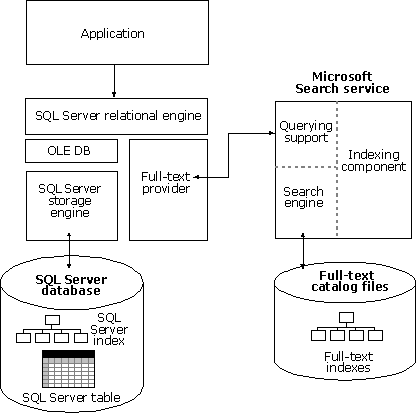Full-text Querying Support
When Microsoft® SQL Server™ receives a Transact-SQL statement with a full-text construct, it retrieves the needed information from the Microsoft Search service using the full-text provider. Full-text constructs are the CONTAINS or FREETEXT predicates, or the CONTAINSTABLE or FREETEXTTABLE rowset functions. The full-text constructs can reference multiple columns in the full-text index if it is not known which column may contain the search conditions.
The components involved in this process are:

- An application sends SQL Server a Transact-SQL statement with a full-text construct.
- The SQL Server relational engine validates the full-text construct by querying the system tables to determine if the column reference is covered by a full-text index. The relational engine reduces each SQL statement to a series of rowset operations, and uses OLE DB to pass the operations to underlying components, usually the storage engine. The relational engine transforms any full-text construct into a request for a rowset from the full-text provider instead of the storage engine. The rowset requested is the set of keys satisfying the search condition and a ranking indicating how well the data for each key met the search condition criteria. The command sent with the rowset request to the full-text provider includes the full-text search condition.
- The full-text provider validates the request and changes the search conditions to a form used by the querying support component of the Microsoft Search service. The request is sent to the search service.
- The querying support component uses the search engine component to extract the requested data from the full-text index. This data is then passed back to the full-text provider in the form of a rowset.
- The full-text provider returns the rowset to the relational engine.
- The relational engine combines all the rowsets it receives from the storage engine and the full-text provider to build the final result set it sends back to the client.
See Also
(c) 1988-98 Microsoft Corporation. All Rights Reserved.

